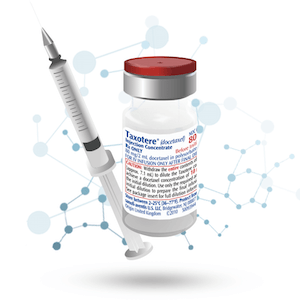Taxotere Overview - How Docetaxel Chemotherapy Works
 Our Taxotere overview begins with the drug’s 1996 launch in the U.S. market. Taxotere is now a well-established, injectable chemotherapy drug prescribed for locally advanced or metastatic breast cancer treatment. Sanofi-Aventis US submitted the drug for approval as a new adjuvant breast cancer treatment to the Food and Drug Administration in 1996, which it quickly won. Then in 1998, the FDA expanded approval to treat first-line metastatic breast cancer, non-small cell lung cancer, advanced stomach cancer, head and neck cancer as well as metastatic prostate cancer.
Our Taxotere overview begins with the drug’s 1996 launch in the U.S. market. Taxotere is now a well-established, injectable chemotherapy drug prescribed for locally advanced or metastatic breast cancer treatment. Sanofi-Aventis US submitted the drug for approval as a new adjuvant breast cancer treatment to the Food and Drug Administration in 1996, which it quickly won. Then in 1998, the FDA expanded approval to treat first-line metastatic breast cancer, non-small cell lung cancer, advanced stomach cancer, head and neck cancer as well as metastatic prostate cancer.
Taxotere Overview: Studies On Permanent Hair Loss Side Effect
Recently, Taxotere (docetaxel) came under increased scrutiny by the FDA and consumers for one specific adverse reaction — permanent hair loss. Independent studies show anywhere from 6.2% to 15% of Taxotere patients experienced a symptom initially downplayed on its label: alopecia. In other words, the hair loss many cancer patients expected to suffer temporarily during chemotherapy can actually be permanent.
In most cases, hair regrowth begins approximately 3-6 months after completing chemotherapy treatment. However, breast cancer survivor Shirley Ledlie went bald after receiving Taxotere in 2005 and had no regrowth three years later. Frustrated, Leslie reached out directly to European medical authorities as well as Sanofi’s UK branch in 2008. As a result, Leslie finally received a response from Sanofi’s officials. The company told her in a follow-up with patients 55 months after receiving docetaxel during their breast cancer treatment regimen, only 3% reported “prolonged significant alopecia.” In other words, only 7 out of 496 study participants had permanent hair loss. Notably, Sanofi also stated they found just one case of permanent hair loss classified as “non-reversible alopecia” among all patients. This would seem rare and unusual for patients worried about the timing and duration of hair loss from Taxotere treatment.
Taxotere Overview: Use In Chemotherapy Combinations
During the 2003 adjuvant chemotherapy trials, TAC (Taxotere, Andriamycin, Cytoxan) reduced risk of death from early stage breast cancer by 30%. For this reason, oncologists quickly prescribed it as a “superior” replacement for the formerly standard FAC (5-Flourouracil, Doxorubicin, Cyclophosphomide) treatment. Afterwards, most node-positive breast cancer patients were prescribed TAC. In most cases, TAC became the “new” go-to chemo regimen, replacing FAC as standard adjunctive chemotherapy treatment for 20 years.
Dr. I. Craig Anderson participated in the BCIRG 001 trial conducted by the Breast Cancer International Research Group (BCIRG). Dr. Anderson admitted that since they didn’t observe patients receiving dose-dense therapy, they couldn’t answer the most important question. What patients as well as oncologists should be asking was: Comparatively speaking, which combined chemotherapy medication really was the best treatment — TAC or FAC? When it came to measuring the superiority of TAC over FAC, comparing long-term survival rates of 75% for patients given the new drug combination vs. 68% given traditional treatment was a deciding factor, he said: “TAC clearly represents an improvement. There’s no question about that.”
Taxotere Overview: FDA Adds Boxed Warning Label in 2015
In 2005, the GEICAM 9805 study showed 9.2% of patients given Taxotere experienced long-term hair loss that began or worsened specifically after the drug was administered. Significantly, some patients with alopecia reported a median duration time of 10.5 years. Despite the psychological toll from such a visible long-term side effect, Sanofi didn’t update the drug’s packaging until December 2015. The FDA finally added a Taxotere boxed warning label about increased risk of permanent hair loss listed under “adverse reactions.”
Taxotere Overview: Lawsuits Now Pending Against Sanofi
During early 2016, several former patients treated over the past two decades with Taxotere as part of their chemotherapy drug regimen filed lawsuits against Sanofi. First was breast cancer survivor Erma Spann of Illinois (who was administered Taxotere post-mastectomy in 2005). California resident Ami Dodson filed the second Taxotere lawsuit. Dodson alleges the company intentionally promoted Taxotere as “more effective” than other, similar taxane-based chemotherapy drugs, despite knowing about the increased permanent hair loss risk.
Since filing the first Taxotere lawsuit against Sanofi in early 2016, more than 30 additional plaintiffs made similar allegations. They demand justice in court for Sanofi’s failure to warn patients about the risk of permanent hair loss. Finally, in October 2016, all federal lawsuits against Sanofi were consolidated into a class action lawsuit.
Check your eligibility for compensation.
If you or a loved one experienced permanent hair loss after completing Taxotere chemotherapy, you may qualify for compensation from the manufacturer. Request your free case evaluation now to see if you may qualify.




